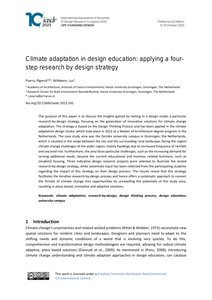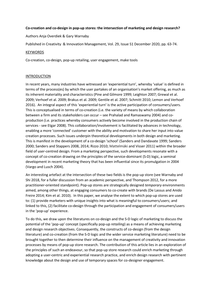A level designer typically creates the levels of a game to cater for a certain set of objectives, or mission. But in procedural content generation, it is common to treat the creation of missions and the generation of levels as two separate concerns. This often leads to generic levels that allow for various missions. However, this also creates a generic impression for the player, because the potential for synergy between the objectives and the level is not utilised. Following up on the mission-space generation concept, as described by Dormans, we explore the possibilities of procedurally generating a level from a designer-made mission. We use a generative grammar to transform a mission into a level in a mixed-initiative design setting. We provide two case studies, dungeon levels for a rogue-like game, and platformer levels for a metroidvania game. The generators differ in the way they use the mission to generate the space, but are created with the same tool for content generation based on model transformations. We discuss the differences between the two generation processes and compare it with a parameterized approach.
LINK
In this paper we explore the influence of the physical and social environment (the design space) son the formation of shared understanding in multidisciplinary design teams. We concentrate on the creative design meeting as a microenvironment for studying processes of design communication. Our applied research context entails the design of mixed physical–digital interactive systems supporting design meetings. Informed by theories of embodiment that have recently gained interest in cognitive science, we focus on the role of interactive “traces,” representational artifacts both created and used by participants as scaffolds for creating shared understanding. Our research through design approach resulted in two prototypes that form two concrete proposals of how the environment may scaffold shared understanding in design meetings. In several user studies we observed users working with our systems in natural contexts. Our analysis reveals how an ensemble of ongoing social as well as physical interactions, scaffolded by the interactive environment, grounds the formation of shared understanding in teams. We discuss implications for designing collaborative tools and for design communication theory in general.
MULTIFILE

Academic design research often fails to contribute to design practice. This dissertation explores how design research collaborations can provide knowledge that design professionals will use in practice. The research shows that design professionals are not addressed as an important audience between the many audiences of collaborative research projects. The research provides insight in the learning process by design professionals in design research collaborations and it identifies opportunities for even more learning. It shows that design professionals can learn about more than designing, but also about application domains or project organization.
DOCUMENT

This paper frames the process of designing a level in a game as a series of model transformations. The transformations correspond to the application of particular design principles, such as the use of locks and keys to transform a linear mission into a branching space. It shows that by using rewrite systems, these transformations can be formalized and automated. The resulting automated process is highly controllable: it is a perfect match for a mixed-initiative approach to level generation where human and computer collaborate in designing levels. An experimental prototype that implements these ideas is presented.
DOCUMENT
The purpose of this paper is to discuss the insights gained by testing in a design studio a particular research-by-design strategy, focusing on the generation of innovative solutions for climate change adaptation. The strategy is based on the Design Thinking Process and has been applied in the climate adaptation design studio, which took place in 2022 at a Master of Architecture degree program in the Netherlands. The case study area was the Zernike university campus in Groningen, the Netherlands, which is situated in the verge between the city and the surrounding rural landscape, facing the urgent climate change challenges of the wider region, mainly floodings due to increased frequency of rainfalls and sea level rise. Furthermore, the area faces particular challenges, such as the increasing demand for serving additional needs, beyond the current educational and business related functions, such as (student) housing. Three indicative design research projects were selected to illustrate the tested research-by-design strategy, while systematic input has been collected from the participating students regarding the impact of this strategy on their design process. The results reveal that this strategy facilitates the iterative research-by-design process and hence offers a systematic approach to convert the threats of climate change into opportunities by unravelling the potentials of the study area, resulting in place-based, innovative and adaptive solutions.
DOCUMENT

In solving systemic design challenges designers co-create with professionals from various fields. In the context of innovation in healthcare practices, this study investigates design abilities that healthcare professionals develop by participating in co-design projects. We conducted a mixed-methods research approach consisting of five retrospective interviews with healthcare researchers involved in co-design projects, and a multiple case study (three cases) on the collaboration between design researchers and healthcare professionals. The three cases all aimed at designing tools for healthcare innovation. The cases differ in the healthcare context and the professionals involved: Paediatric physical therapists in the treatment of babies (0-2 years), supervisors (e.g. in assisted living) of people with intellectual disabilities, and academic researchers in social sciences and design research developing e-health applications for elderly people with early stages of dementia. Literature states that healthcare professionals may be competent in specific abilities related to design, but they are not trained to mode-shift and to use two different ways of working for creativity. We found that the healthcare professionals involved in co-design projects developed design ability over time, and that the research setting was supportive. Based on design abilities that the five healthcare researchers explicated in the interviews as having adopted, we suggest eight mode-shift practices related to design, which we investigated in the cases. Findings of the case-study show that two mode-shift practices related to design and innovation are difficult to adopt for healthcare professionals: Generate and synthesize; and keeping track on overview and details. These two design abilities require more training and/or experience than the other six design abilities that ran smoothly in the cases, if healthcare professionals were facilitated in the process. Healthcare professionals specifically relate two of these practices to design: Collaboration and slow down – sprint. This study discusses these findings by referring to an analogy of kayaking on a wild water river: The collaboration aspect of switching between working in a group and by yourself, like a group of kayakers who collaborate in going down stream a river but peddle by themselves in their own boats; the slowdown and sprint aspect, like kayakers who oversee the river in turning waters and sprint in between, rather than go with the flow in a raft.
DOCUMENT

In order for techniques from Model Driven Engineering to be accepted at large by the game industry, it is critical that the effectiveness and efficiency of these techniques are proven for game development. There is no lack of game design models, but there is no model that has surfaced as an industry standard. Game designers are often reluctant to work with models: they argue these models do not help them design games and actually restrict their creativity. At the same time, the flexibility that model driven engineering allows seems a good fit for the fluidity of the game design process, while clearly defined, generic models can be used to develop automated design tools that increase the development’s efficiency.
DOCUMENT

Design and research are two fields of knowledge that each has its traditions, methods, standards and practices. These two worlds appear to be quite separate, with researchers investigating what exists, and designers visualising what could be. This book builds a bridge between both worlds by showing how design and research can be integrated to develop a new field of knowledge. This book contains 22 inspiring reflections that demonstrate how the unique qualities of research (aimed at studying the present) and design (aimed at developing the future) can be combined. This book shows that the transdisciplinary approach is applicable in a multitude of sectors, ranging from healthcare, urban planning, circular economy, and the food industry. Arranged in five parts, the book offers a range of illustrative examples, experiences, methods, and interpretations. Together they make up the characteristic of a mosaic, each piece contributing a part of the complete picture, and all pieces together offering a multi-facted perspective of what applied design research is, how it is implemented and what the reader can expect from it.
MULTIFILE

Introduction: In March 2014, the New South Wales (NSW) Government (Australia) announced the NSW Integrated Care Strategy. In response, a family-centred, population-based, integrated care initiative for vulnerable families and their children in Sydney, Australia was developed. The initiative was called Healthy Homes and Neighbourhoods. A realist translational social epidemiology programme of research and collaborative design is at the foundation of its evaluation. Theory and Method: The UK Medical Research Council (MRC) Framework for evaluating complex health interventions was adapted. This has four components, namely 1) development, 2) feasibility/piloting, 3) evaluation and 4) implementation. We adapted the Framework to include: critical realist, theory driven, and continuous improvement approaches. The modified Framework underpins this research and evaluation protocol for Healthy Homes and Neighbourhoods. Discussion: The NSW Health Monitoring and Evaluation Framework did not make provisions for assessment of the programme layers of context, or the effect of programme mechanism at each level. We therefore developed a multilevel approach that uses mixed-method research to examine not only outcomes, but also what is working for whom and why.
LINK
Co-creation as a concept and process has been prominent in both marketing and design research over the past ten years. Referring respectively to the active collaboration of firms with their stakeholders in value creation, or to the participation of design users in the design research process, there has arguably been little common discourse between these academic disciplines. This article seeks to redress this deficiency by connecting marketing and design research together—and particularly the concepts of co-creation and co-design—to advance theory and broaden the scope of applied research into the topic. It does this by elaborating the notion of the pop-up store as temporary place of consumer/user engagement, to build common ground for theory and experimentation in terms of allowing marketers insight into what is meaningful to consumers and in terms of facilitating co-design. The article describes two case studies, which outline how this can occur and concludes by proposing principles and an agenda for future marketing/design pop-up research. This is the peer reviewed version of the following article: Overdiek A. & Warnaby G. (2020), "Co-creation and co-design in pop-up stores: the intersection of marketing and design research?", Creativity & Innovation Management, Vol. 29, Issue S1, pp. 63-74, which has been published in final form at https://doi.org/10.1111/caim.12373. This article may be used for non-commercial purposes in accordance with Wiley Terms and Conditions for Use of Self-Archived Versions. LinkedIn: https://nl.linkedin.com/in/overdiek12345
MULTIFILE
